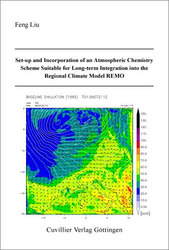| Areas | |
|---|---|
| Serie de libros (96) |
1379
|
| Nachhaltigkeit |
3
|
| Gesundheitswesen |
1
|
| Letra |
2367
|
| Ciencias Naturales |
5407
|
| Matemática | 229 |
| Informática | 319 |
| Física | 980 |
| Química | 1364 |
| Geociencias | 131 |
| Medicina humana | 243 |
| Estomatología | 10 |
| Veterinaria | 108 |
| Farmacia | 147 |
| Biología | 835 |
| Bioquímica, biología molecular, tecnología genética | 121 |
| Biofísica | 25 |
| Nutrición | 45 |
| Agricultura | 1004 |
| Silvicultura | 201 |
| Horticultura | 20 |
| Ecología y conservación de la tierra | 148 |
| Ciencias Ingeniería |
1793
|
| General |
98
|
|
Leitlinien Unfallchirurgie
5. Auflage bestellen |
|
Erweiterte Suche
Set-up and Incorporation of an Atmospheric Chemistry Scheme Suitable for Long-term Integration into the Regional Climate Model REMO (Tienda española)
Feng Liu (Autor)Previo
Indice, Datei (110 KB)
Lectura de prueba, Datei (970 KB)
The general aim as formulated at the start of this Ph.D. research has been to compose a state-of-the-art three-dimensional regional scale atmospheric transport chemistry model (CTM) which can be used for both long-term tropospheric chemistry and regional air quality simulations. REMO has been extended by a photo-chemical reaction scheme, ReLACS (Crassier et al., 2000) as a secondary lumped chemistry mechanism of the RACM (Stockwell et al., 1997) is used for that purpose. A program that allows on-line photolysis rate calculations (FAST-J2) (Wild et al., 2000) and an efficient ODE solver (CHEMEQ2) based on \alpha-QSS approach (Mott et al, 2000; Mott and Oran et al., 2001) are utilized. We refer to this extended REMO as RECCM (REgional Climate Chemistry Model). With the aid of this model the processes and their interactions that control the chemical composition of the troposphere can be investigated.
In order to reach the aim described above the first step is to build up and validate the chemical module, which is one of the most important components in the 3-D model. With well-designed scenarios (Poppe et al., 2001) a validation test of the chemical module was carried out using our box model. The test results was analyzed and evaluated through comparing with reference based on RACM.
The processes involved in continuity equation of species include horizontal advection, vertical advection and turbulent diffusion, re-distribution due to cumulus convective system, chemical transformation, dry deposition and emission rates. The appropriate numerical schemes for solving each process by operator splitting are proposed. The interface between REMO and the chemical module is developed through which the real time variables, i.e., cloud optical depth, surface albedo, pressure and temperature profiles from REMO are transferred into chemical module for chemical rate constants and photolysis rates calculations at each time step. The modeled ozone profile is used for ozone input for photolysis rates calculation. A proper approach to deal with EMEP emission data is proposed. This approach can provide the hourly input of emissions to the model. In result the first version of RECCM becomes available. The baseline simulation of the year of 1999 is carried out after model set up is finished. Annual cycle of ozone and oxidants are obtained by the simulation. The quality of model runs are analysed by comparing with wide range of observation data over Europe. The basic features of ozone spatial distribution and seasonal variation over Europe in 1999 are identified from the measurements. The three typical patterns over Europe derived from observations agree well with the results from measurements covered the time period March 1989 – February 1993(Scheel et al., 1997). The model simulations have ability to reproduce the regional patterns. The case study of early spring ozone in Spain shows the ability of RECCM to simulate this ongoing debate issue. The results suggest that early spring ozone for this case is mainly caused by downward transport of ozone rich air from upper levels rather than due to regional scale photochemistry. In addition the simulation of a pronounced high ozone episode during 29 July to 4 August 1999 is presented and analyzed. RECCM performance is reasonable according to comparing simulations against observations.
The model is evaluated based on model quality objectives (MQO). The model quality is comparable with three of six models involved in inter-comparison of CTMs within GLOREAM. However the same kind of simulation data, for example, one annual cycle of 1999 from these models is needed if a full version inter-comparison has to be implemented.
| ISBN-10 (Impresion) | 3867272735 |
| ISBN-13 (Impresion) | 9783867272735 |
| Formato | A5 |
| Idioma | Inglés |
| Numero de paginas | 124 |
| Edicion | 1 |
| Volumen | 0 |
| Lugar de publicacion | Göttingen |
| Lugar de la disertacion | Cottbus |
| Fecha de publicacion | 03.07.2007 |
| Clasificacion simple | Tesis doctoral |
| Area |
Geociencias
|








